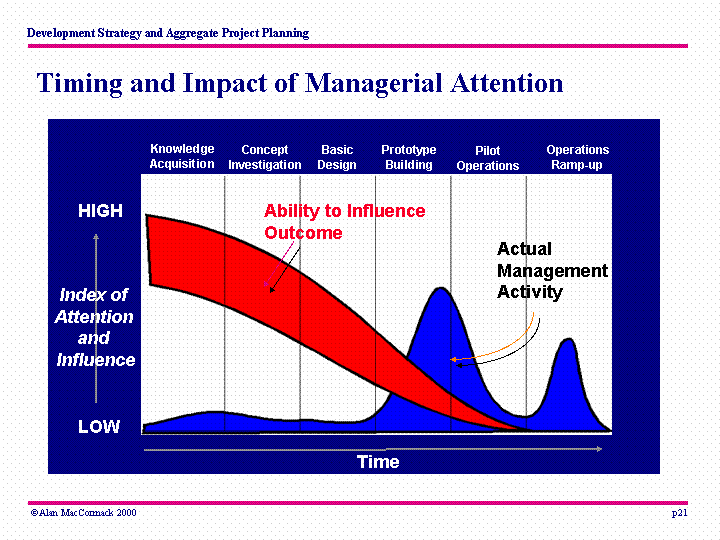New Role for Senior Management
From Leading Product Development: The Senior Manager's Guide to Creating and Shaping the Enterprise, Steven Wheelwright and Kim Clark, The Free Press, New York, NY 1995
Project Phases and Management Attention
Wheelwright and Clark suggest that most senior management attention happens during phases of a project where their potential for influencing the project is relatively small and that little attention is payed during the early phases of a project when the potential for influence is greatest.
| These are the phases where the ability to influence the outcome is highest. | Build Knowledge and Capability |
| Idea Generation | |
| Project definition and selection | |
| These are the phases where many senior managers spend activity. | Design and build prototypes |
| Pilot production | |
| Manufacturing ramp up |
Excellent senior managers:
- They set direction and get people in the organization aligned.
- They select, train, and develop people capable of realizing the vision.
- Through these people they create, shape, and influence how work gets done to ensure that it gets done in the best way possible.
The Self-Reinforcing Behavior of Traditional Product Development Approaches
Why do Senior Managers not get involved in the first three phases?
- Easy to be wrong
- A lot of knowledge is involved
- Problems are less defined, and tools / roles are not clear
- Lack of metrics / Long Feedback Loops
- Absence of urgency
Why do senior managers come in at the last minute to save projects?
- Low risk / High return – project is already failing, the problem to be solved is well defined
- It’s urgent and visible
- Firefighting skills – this is what SM have been trained to do
- It’s exciting
Leadership Roles of Senior Management
If there is a development strategy in place, because Senior Management monitors projects in the aggregate, and because the individual projects make sense, the leaders are rarely called on to pull irons from the fire. Rather, they are in the service business, providing resources, technology, skill and capability when and where teams need it.
| Front-End Roles | Back-End Roles |
| Direction setter – involves imagination, judgement, and knowledge so that the future of the business can be envisioned. | Team Launcher – develop and approve charters for projects that have been designed to realize specific objectives established by the product line architecture and the business strategy. |
| Product Line Architect – need to develop the right set of projects, what should be developed and in what sequence | Energy Source – Senior Management must build the skills and capabilities – the organizational energy – needed for successful development. Must ensure that individual project teams get what they need to be successful. |
| Portfolio Manager – Senior Management must have the ability to understand the relationship between the business of an enterprise and the total set of projects undertaken. The projectrs undertaken must be managed in aggregate. The people in the organization must also be managed. | Commitment Manager – Senior Management must review projects to influence, guide, facilitate, and review commitments. |
| Process owner / Creator – Senior Management owns the development process, they are responsible for its content and performance. SM must understand the work that needs to be done to conceive of, design, develop and introduce new products. | Sponsor / Coach – Senior Management plays critical supportive role giving direction, and guidance to interpret events, deal with unexpected contingencies, and otherwise negotiate the relationship between the individual projects and the total set of activities. |
| Process Improver – SM needs to make sure that what is learned on one project is transferred to another.Focus on doing the right thing and on doing it the right way. |
